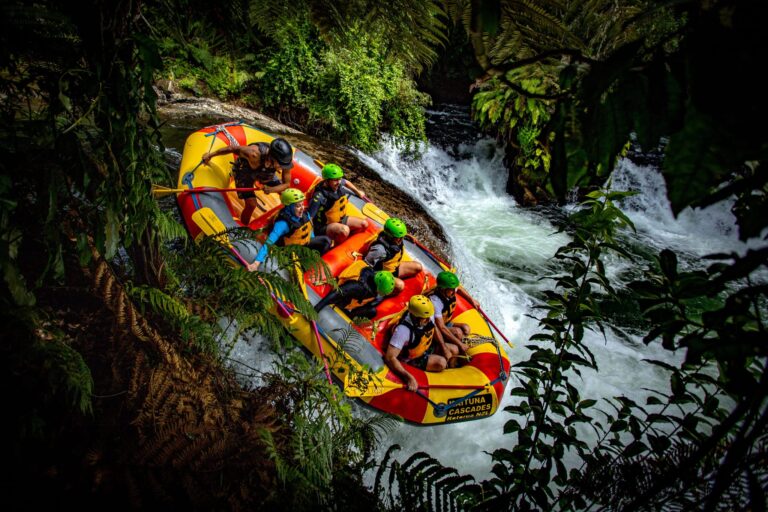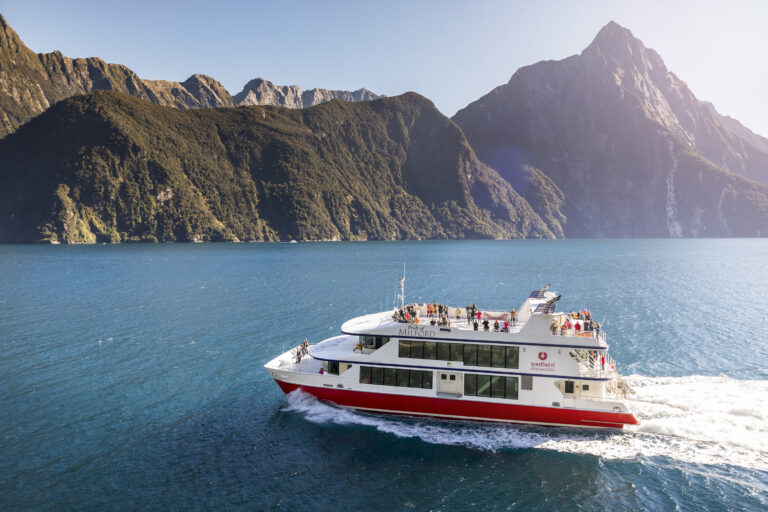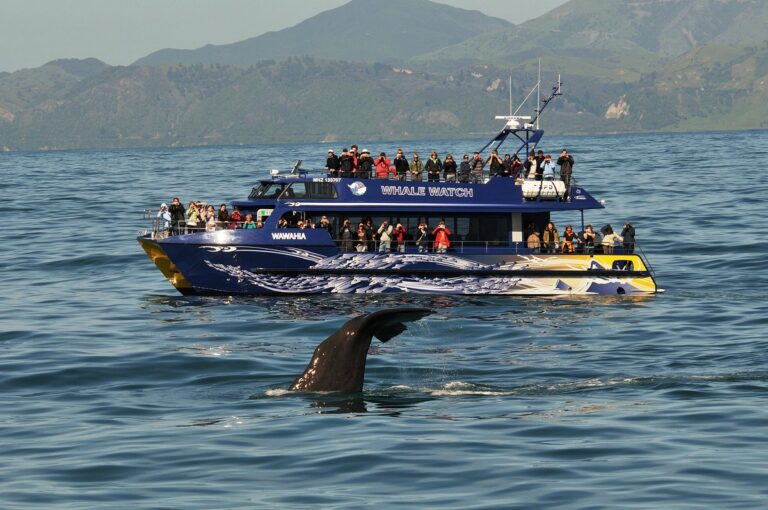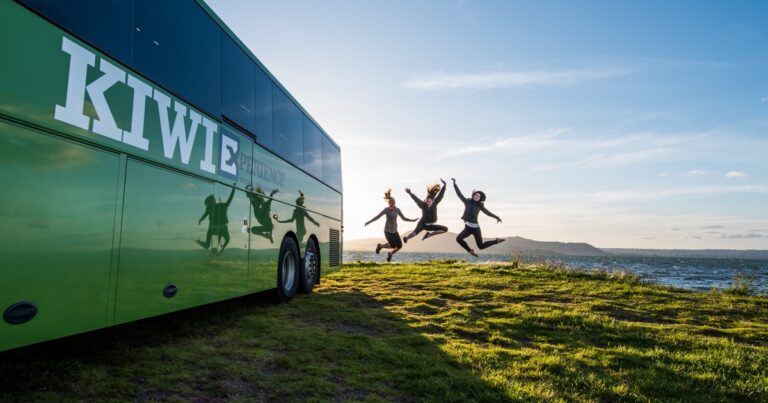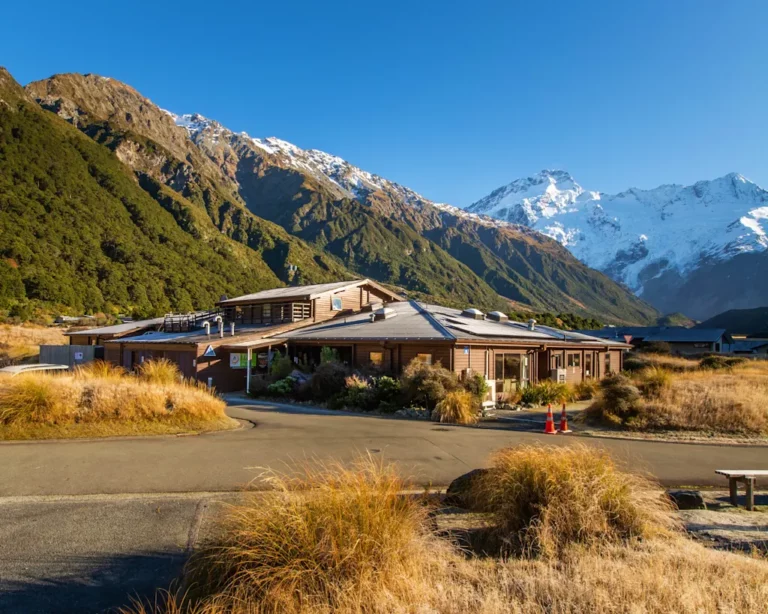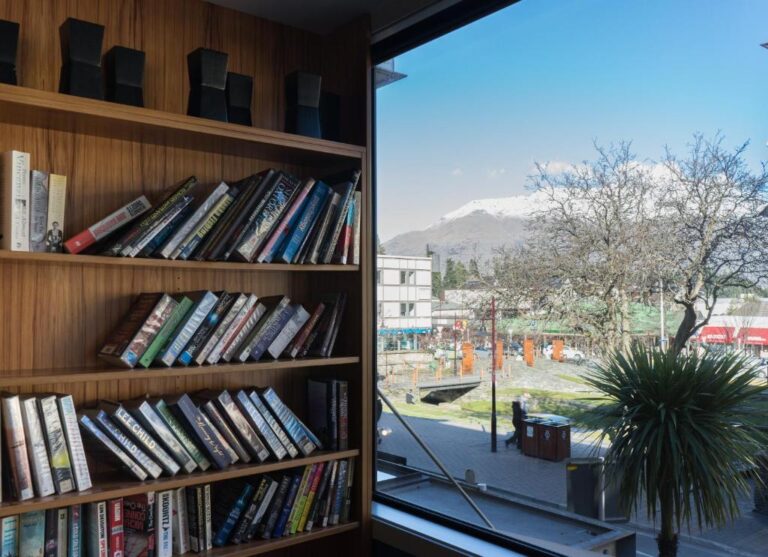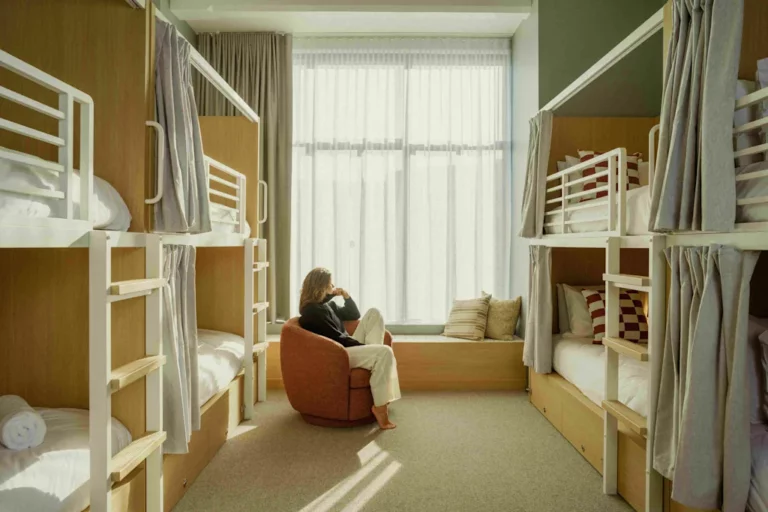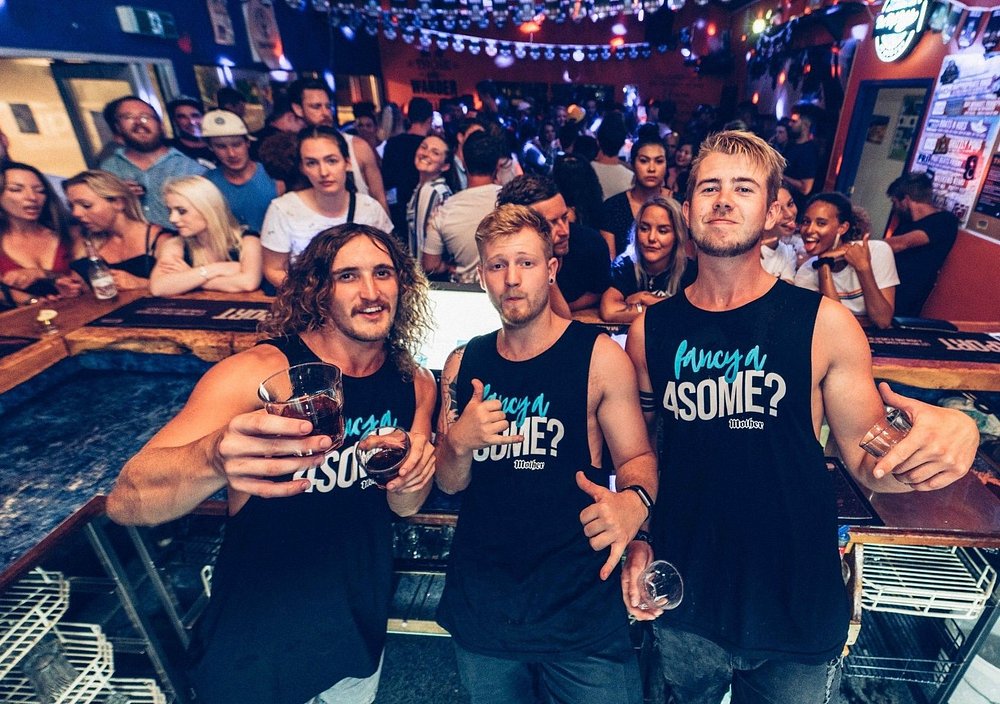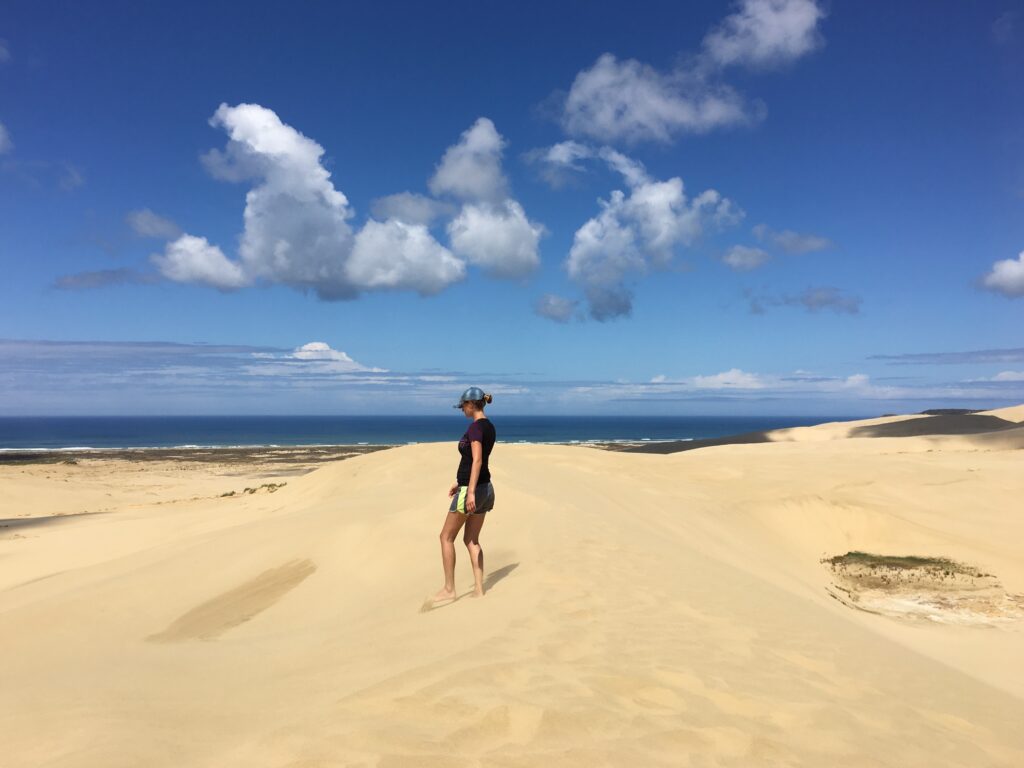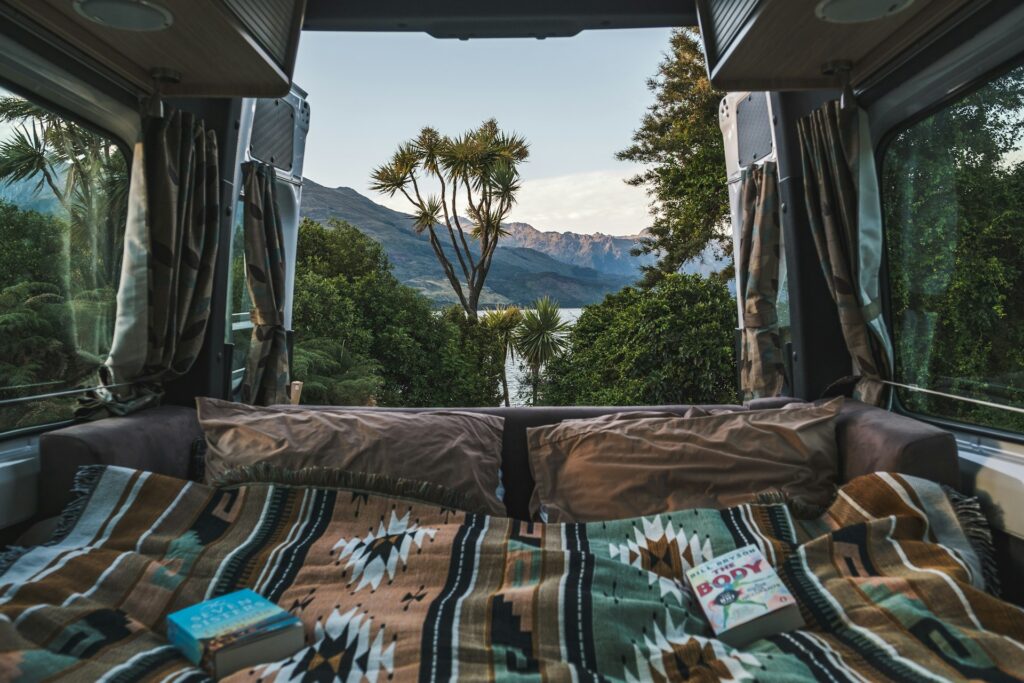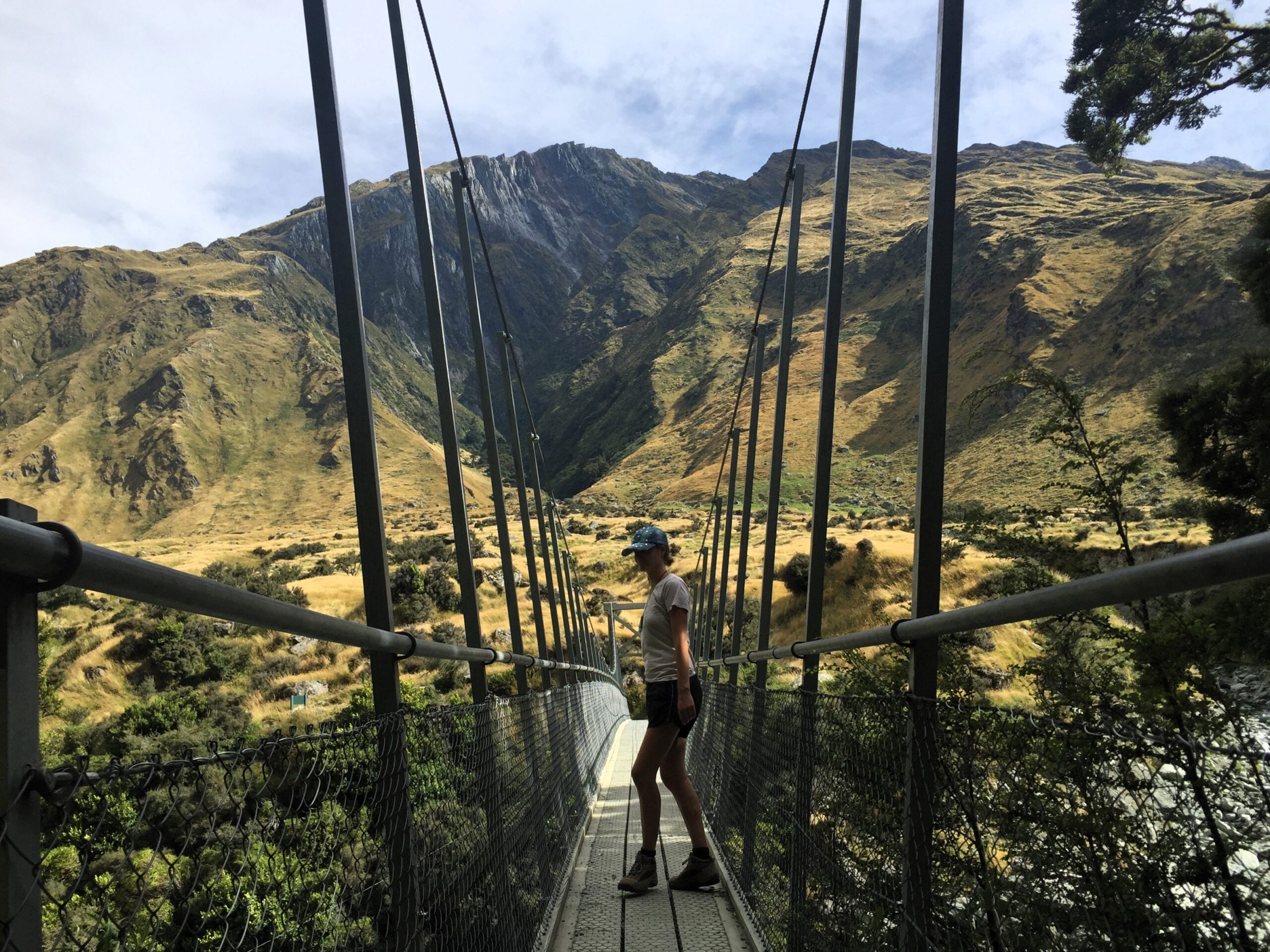
It’s hard to beat that feeling you get when you disembark the Interislander ferry in Picton and set off on your South Island adventure. You’ve arrived in a land of epic scenery, adventure sports, glaciers, and peaceful bays. There’s an abundance of things to do in New Zealand’s South Island.
Every corner delivers postcard-perfect views. There’s mountains and lakes for days—just driving through the scenery is enough. It’s what makes New Zealand the ultimate place to explore with a campervan.
But what are the highlights? And how do you even go about selecting them when the entire island is practically a highlight in itself.
There are definitely a few that stand out. Here are our top 25 things to do in New Zealand’s South Island for an adventure you’ll never forget.
Reader beware—the South Island is a seductress. She will sweep you off your feet. Welcome to the wild side. 🏔️
1. Milford Sound: The eighth wonder of the world
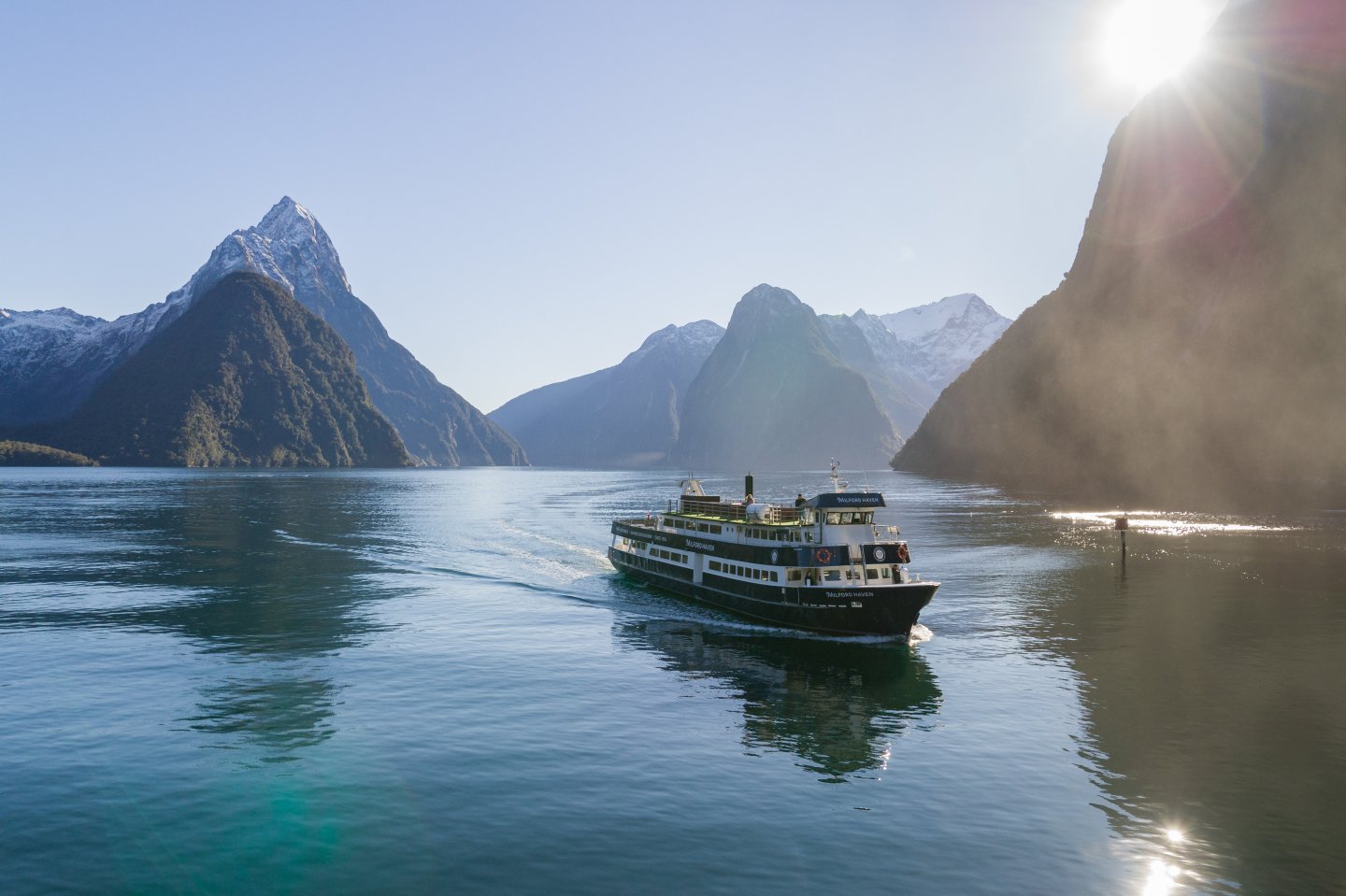
There’s no surprise here—sorry folks. We appreciate a hidden gem as much as a highlight, but there’s no disputing the sheer natural beauty of this wonder. And it really is a wonder.
The first time we ever visited Milford Sound was actually after touring almost everywhere else in New Zealand (several times). Talk about saving the best for last! The drive from Te Anau absolutely blew our minds. Four words—out of this world. And this was before we even arrived at Milford Sound.
This place is the definition of pure nature. It lives and breathes all around you. Milford Sound doesn’t just live up to the hype, it goes above and beyond. Towering cliffs cloaked in rainforest plunge into inky fjord waters, waterfalls tumble hundreds of metres, and mist clings to granite peaks.
Even after seeing a thousand photos, the real thing still makes your jaw drop. Hands down the best thing to do here is board a boat cruise that’ll take you into the sound. Suddenly all those long days picking fruit in Cromwell hit home.
🚙 Getting there: Milford Sound is a 1 hour 45 minute drive north from Te Anau (4 hours from Queenstown). There’s also daily Intercity services. Plus hop-on hop-off tours like Kiwi Experience.
RealNZ cruise
Let’s cut to the chase. If you’re on a budget (like we were) and looking for the best boat tour to spend your money on (anywhere)—look no further.
RealNZ’s tours take you right into the heart of the fjord where you can experience the full length of it up close. You’ll cruise beneath the dramatic Mitre Peak, the tallest mountain in the area, sail past waterfalls, spot seals sunbathing on rocks, and if you’re lucky, even dolphins and penguins.
The boat guides are super knowledgeable, sharing cool facts about the area’s geology and history—it’s a spot that’s been shaped by glaciers over millions of years!
For a more immersive trip, you can kayak the fjord or take an overnight cruise to watch the sun dip behind Mitre Peak. Plus, they operate eco-friendly boats, so you can feel good about your travel choices. A RealNZ tour is a must-do on your backpacking journey.
Lake Marian
No credit card required here—just a decent level of fitness. Lake Marian herself is a bit of a hidden gem in the Fiordland National Park. She sits in a hanging valley, offering a spectacular reflective surface with calm weather.
The track to Lake Marian begins 40 minutes south of Milford Sound (off SH94). Turn into Hollyford Road and drive 1 kilometre to the carpark. The track will take you about 3 hours return to trek—not including stops.
Make your way over suspension bridges, through beech forest, and past waterfalls, to a glassy alpine lake surrounded by snow-capped peaks. This is an advanced tramping trail so be prepared for some steady uphill metres. The payoff is worth it!
We recommend this track for those that love hiking and anyone looking for a short trail in Fiordland that’s less busy. You’ll need your own ride, and we suggest getting an early start if you’re combining the trail with a trip to the sound.
🛌 Where to stay: The closest DOC campsite is Cascade Creek Campsite. The nearest hostels are in Te Anau. Check out Te Anau Lakefront Backpackers.
2. Aoraki / Mount Cook: Alpine peaks and starry skies

Welcome to the rooftop of New Zealand! Quite literally. Aoraki / Mount Cook is the country’s tallest mountain (3,724 m) and the centrepiece of the Southern Alps.
This is classic South Island scenery—snow-capped summits, turquoise lakes, and scenic trails that make you stop and pinch yourself. We’re transported back to the drive up Mount Cook Road—the weather was moody and it created a bit of an optical spectacle with the looming alps in the background.
🚙 Getting there: Aoraki / Mount Cook is a 1 hour 10 minute drive northwest from Lake Tekapo (3 hours from Queenstown). There’s also hop-on hop-off tours like Kiwi Experience.
Lake Pukaki
Before you even reach the national park, pull over at Lake Pukaki—a must-see on your way to Mount Cook Village. The lake is situated directly on the right of Mount Cook Road and runs north alongside it.
Lake Pukaki is one of New Zealand’s most photogenic spots, with its striking turquoise waters and stunning backdrop of Mount Cook. In fact, it sits at the foot of the Southern Alps and is fed by glacier meltwater, giving it that vibrant, almost unreal blue colour. It’s a popular stop for those heading to Mount Cook, but it also offers plenty to do on its own.
You can stroll along the lake’s edge, take in the views, or hit up one of the many nearby viewpoints. On clear days, you can see Aoraki reflected perfectly in the lake. Plus, the nearby walking tracks give you more chances to explore the landscape and get up close with the area’s unique flora and fauna.
Hooker Valley Track
The Hooker Valley Track is one of New Zealand’s most stunning day hikes, and it’s a must-do if you’re heading to Aoraki / Mount Cook National Park.
You can currently hike the track as far as the Kakīroa / Mount Sefton View Lookout. From this point the track is closed until probably Autumn 2026. But don’t let that deter you from doing the open section!
The Mount Sefton View Lookout makes a pretty easy 1 hour return hike. You’ll encounter jaw-dropping views of snow-capped peaks, glaciers, and alpine fields around Mueller Lake.
Keep an eye out for the occasional cheeky kea (native alpine parrot). We recommend combining this trail with the Kea Point Track (1-2 hours) for better views of Aoraki / Mount Cook.
Stargazing – International Dark Sky Reserve
Mount Cook Village sits within the Aoraki Mackenzie International Dark Sky Reserve—one of the world’s best stargazing locations. With virtually no light pollution, you’ll see some of the clearest, most unpolluted skies in the world. It’s an experience that’ll make you feel like you’re floating in space! You can join a guided stargazing tour at the Hermitage Hotel’s observatory, or just wrap up warm and gaze from your campsite.
The guided stargazing tours take you to the best spots to see the constellations, planets, and if you’re lucky, the Southern Lights (March-September). Using high powered telescopes, knowledgeable guides share fascinating facts about the southern hemisphere’s night sky, pointing out key stars and constellations. If you’re into astrophotography, bring a tripod, this is the place to get some next-level shots.
🛌 Where to stay: Treat yourself to a proper sleep. We recommend Haka House Aoraki / Mt Cook—make sure you take advantage of that sauna!
3. Queenstown: Backpacking capital of the world
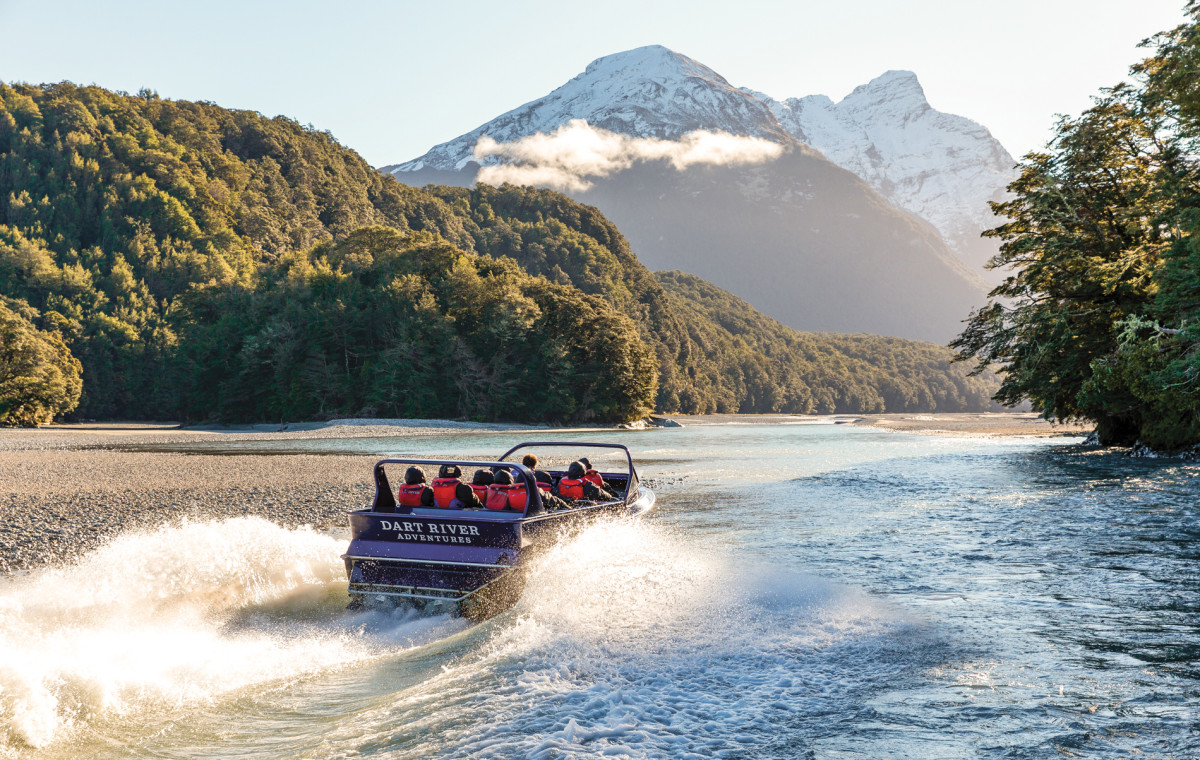
Everything about Queenstown screams backpacking. Over the past few decades it’s evolved into one of the most desirable backpacking destinations on the planet. Seriously—we reckon it’s a contender for backpacking capital of the world. This place lives and breathes it every day.
We’re partial to off-the-grid adventures, but (and it’s a big butt) Queenstown is the exception. This place will fill your spirit big time, man.
With endless fun and adventure around every glacial river, Queenstown isn’t just a destination—it’s an experience. Every street corner hums with energy, every view looks like a postcard, and adventure is basically mandatory.
Backpackers from all over the world gather here to push their limits and swap stories by Lake Whakatipu. It’s positively buzzing with things to do, and we don’t take this task lightly. Here’s a few of our top picks for Q-Town.
🚙 Getting there: Queenstown is a 7 hour drive southwest from Christchurch. There’s also daily Intercity services. Plus hop-on hop-off tours like Kiwi Experience.
Dart River Adventures
Located in Glenorchy (45 minutes from Queenstown), this unique experience lets you explore the Dart River by jet boat, kayak, or even on foot. Dart River Adventures is an absolute blast for anyone looking for a hit of adrenaline while taking in the stunning scenery of the Dart River Valley.
The jet boat ride is a high-speed thrill that zips through narrow canyons and past towering mountains, while offering incredible views of the untouched landscapes of Mount Aspiring National Park. Boasting some of the most beautiful scenery in the world.
If you’re into a more relaxed pace, you can opt for a guided wilderness walk through ancient forests, where you’ll be surrounded by beech trees and crystal-clear glacier-fed rivers.
The area’s dramatic beauty was featured in The Lord of the Rings, so you might recognise some iconic spots from the movies, like the Isengard Lookout.
Dart River Adventures is the perfect combo of adventure, nature, and LOTR magic—making it a must-do if you’re backpacking in the Queenstown area and looking to get off the beaten path.
Shotover Canyon Swing
The Shotover Canyon Swing is one of the wildest, most thrilling experiences you can have in Queenstown. Imagine yourself free-falling from a 109 metre (360 feet) platform through the air into a canyon with nothing but the breathtaking Shotover River below you, and rugged mountains around you.
This is the world’s highest cliff jump—and a total bucketlister for adrenaline junkies. You’ll freefall a total of 60 metres before swinging over the canyon. The views here are insane, and the rush is f#@king mind-blowing.
What makes the swing stand out is the choice to jump any way you want. You can choose from a variety of jumps, including the “Gimp Boy Goes to Hollywood” (an 8-second upside down freefall) or even a tandem jump if you’re feeling brave enough to share the experience with a travelmate.
Whether it’s backwards, blindfolded, or in a running start, the swing lets you control the thrill factor. Don’t worry if you’re nervous (it’s only natural!)—the crew is there to make you feel as comfortable as possible.
Arrowtown

Once a bustling gold mining town in the 1800s, Arrowtown has managed to retain much of its old-world charm, with well-preserved 19th-century Victorian-style buildings lining the streets. Today, it’s a peaceful and picturesque place, brimming with history and character. Located just 20 minutes from Queenstown, it’s laid-back vibe is perfect for that much-needed breath of fresh air from all the action.
You can wander through the quaint streets, browse the local boutique shops, or grab a coffee in one of the cozy cafés. A highlight is the Arrowtown Chinese Settlement, where you’ll learn about the Chinese miners who played a big part in the town’s history.
Ford of Bruinen and Gladden Fields
If you’re here for the scenery, the nearby Arrow River offers fantastic riverside trails and biking tracks, and a couple of LOTR spots to check out. In autumn, the trees here turn golden and red and the valley glows—making for stunning photos.
The Arrow River that runs alongside the town was used as a filming location for The Lord of the Rings. Specifically, the Ford of Bruinen and Gladden Fields. Both are just a few minutes walk from the village and are easily recognisable—we got just a little bit excited!
Arrowtown’s mix of history, charm, and cinematic magic makes it a unique little gem if you’re backpacking Queenstown.
👉🏼 Discover more of our Queenstown faves in our dedicated guide: 8 best things to do in Queenstown for free.
🛌 Where to stay: Options galore here! We recommend the award-winning Adventure Queenstown Hostel. Make sure you book ahead of time, especially during summer. Hostels in Queenstown fill up fast.
4. Mount Aspiring National Park: Glaciers and off-the-grid hiking
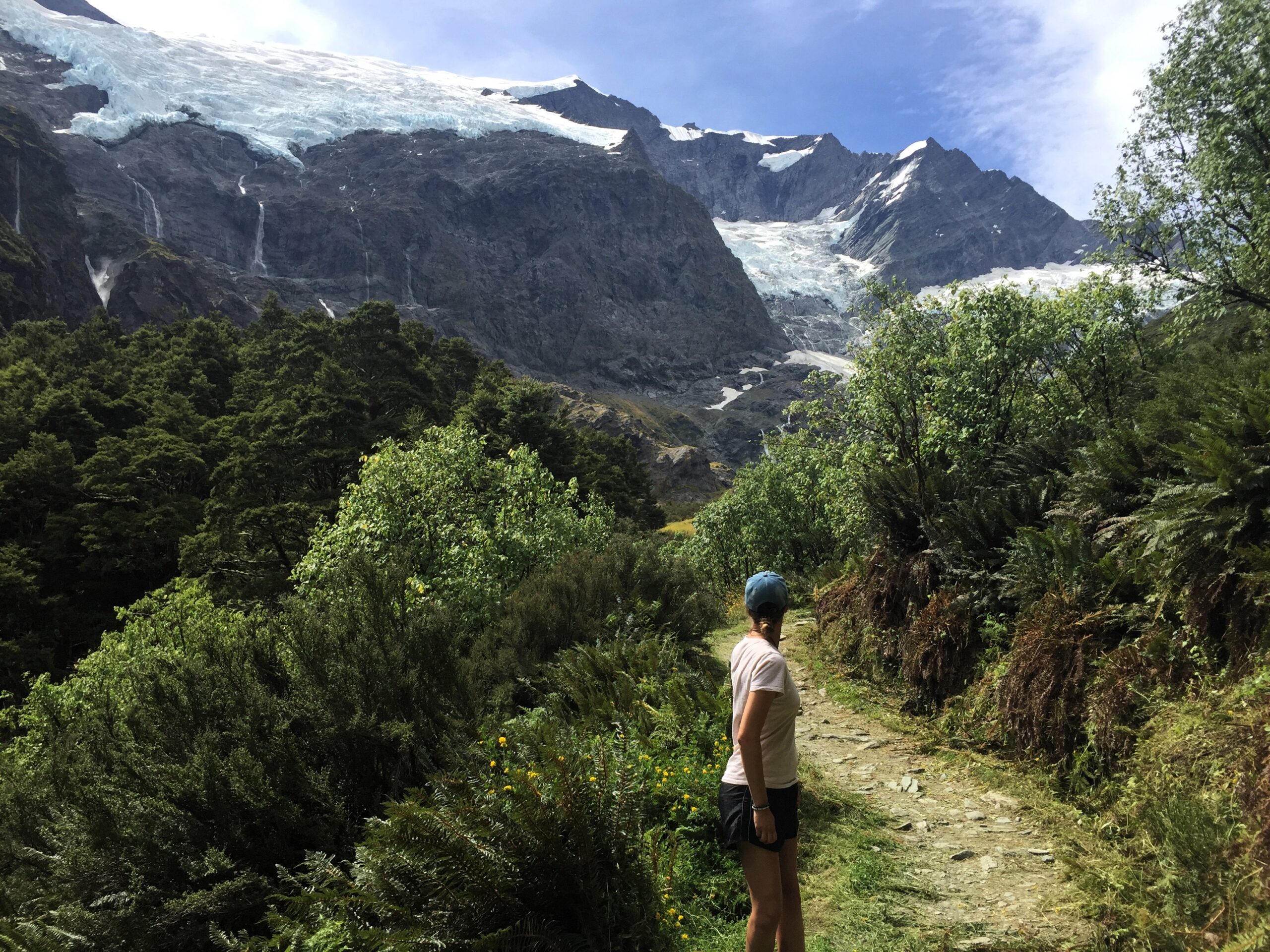
Make your way 1 hour west of Wānaka to the Raspberry Flat Carpark, at the base of the Mount Aspiring National Park. This is a UNESCO World Heritage area filled with alpine peaks, blue ice, and roaring rivers. It’s less crowded than Aoraki / Mount Cook, more off-the-grid, and just as breathtaking.
🏞️ Pro tip: The last 30 km stretch of this road is gravel and crosses numerous fords (water over the road)—check the weather and road conditions beforehand.
Rob Roy Track
This 10 km return track is one of the South Island’s most scenic day hikes—and it’s seriously rewarding. The trail crosses a swing bridge, winds through alpine forest, and opens into a valley where you’ll see waterfalls cascading down the face of Rob Roy Glacier.
The glacier itself is an epic sight to see and makes this one of our fave hikes of this length in New Zealand. The full track will take you about 3-4 hours to complete.
Look out for kea (New Zealand’s cheeky alpine parrot) showing off near the viewpoint!
Shotover Saddle Route
For expert hikers (we mean that!) the Shotover Saddle Route offers a challenging 6 hour trek with rewarding views of the West Matukituki and Rob Roy valleys. Including Rob Roy Peak (2,644 m)—not to be confused with Roys Peak, which looks like a baby brother!
The track starts 5 km from the Raspberry Flat Carpark (before the Brides Veil waterfall). The first part of this hike follows the Matukituki River west and is pretty flat. But once you reach the start of the Shotover Saddle Route (the main event) it’s a seriously steep climb up—and things get real fast.
You’ll need a high level of fitness and navigational experience to tackle this one.
🛌 Where to stay: Adventure Wānaka Hostel | Haka House Wānaka.
5. Abel Tasman National Park: Golden beaches and kayak adventures
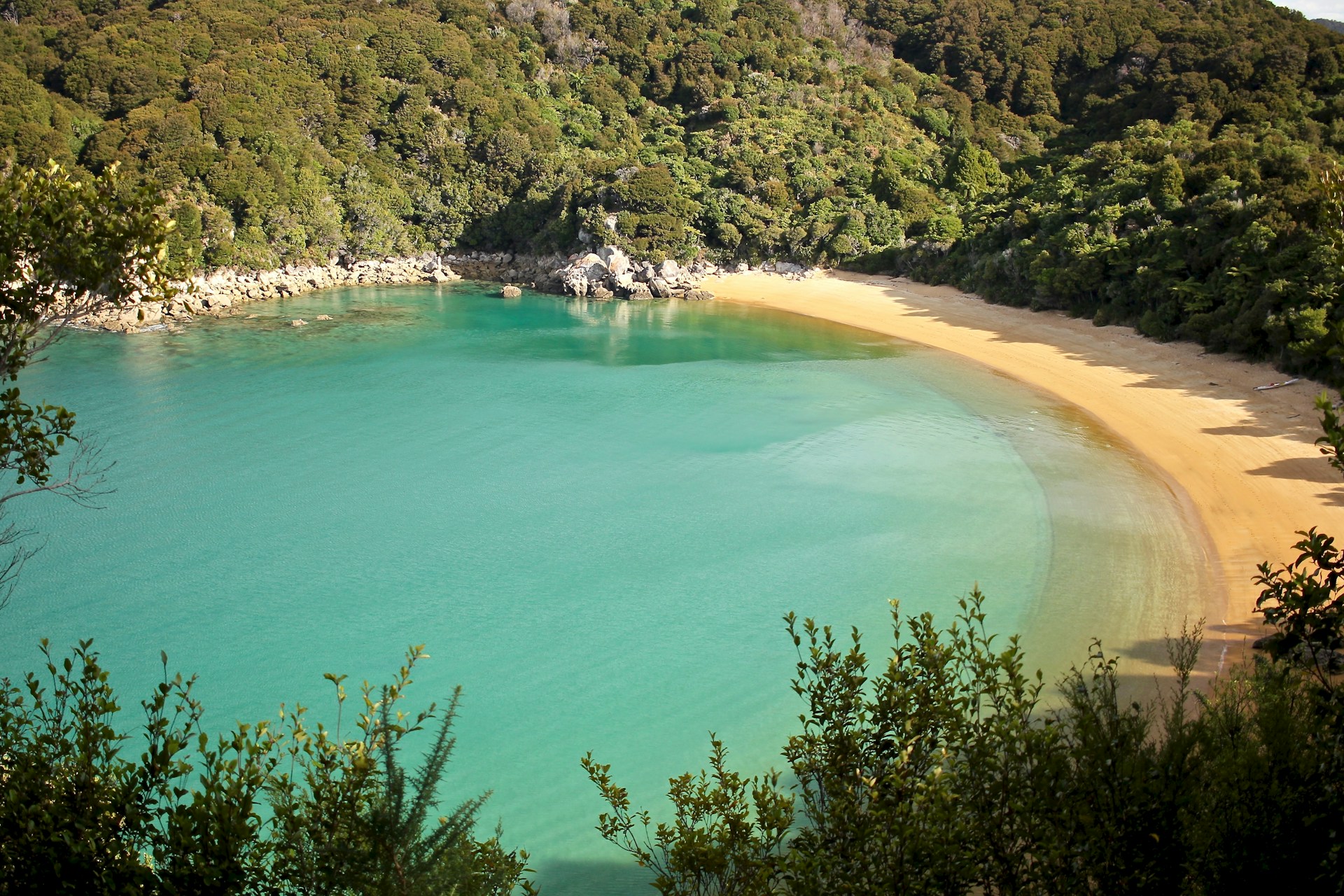
Welcome to New Zealand’s sunniest region!
The Abel Tasman National Park is an absolute dream for anyone who loves beaches, kayaking, or coastal walks. It’s the country’s smallest national park, but it packs serious beauty: golden sand, sculpted granite headlands, and pretty trails through native forest. You’ll discover some of the most stunning coastline in the country.
You can also hike parts of the Abel Tasman Coast Track, one of New Zealand’s Great Walks. The full trail takes 3–5 days, but you can do short sections with water taxis between bays.
If you could design the perfect coastal escape, it would look a lot like Abel Tasman. The vibe is chill, the sun shines more than anywhere else in the country, and life slows down to the rhythm of the tides.
🚙 Getting there: Mārahau (gateway to Abel Tasman) is a 1 hour drive northwest from Nelson. There’s also hop-on hop-off tours like Kiwi Experience.
Abel Tasman Kayaks
The best way to experience Abel Tasman is by kayak. The guided tours typically range from half-day to multi-day excursions, taking you through hidden coves, golden beaches, and the famous Abel Tasman coastline.
Full-day trips often include a picnic lunch on a secluded beach, while multi-day adventures let you camp under the stars at remote bays. Even a half-day tour gives you plenty of time to explore the golden shoreline.
You’ll have the chance to paddle around vibrant marine life and untouched islands. Tours often include a visit to pristine beaches like Tonga Island, home to playful seals. In fact, these guys are one of only three operators authorised to view marine mammals from sea kayaks here. Local guides share fascinating insight about the area’s culture, history, and wildlife.
We recommend kayaking one way and hiking the Coast Track back—so you can explore the best of both worlds. You’ll glide across turquoise water so clear you can see the sea floor! Abel Tasman Kayaks is the ultimate way to explore one of New Zealand’s most stunning national parks.
🛶 Pro tip: Keep an eye out for tiny blue penguins (kororā) and curious seals—they often pop up right beside your kayak.
Split Apple Rock
This giant, perfectly split boulder between Mārahau and Kaiteriteri Beach is a park icon. Split Apple Rock is one of New Zealand’s most famous natural landmarks, resting in the crystal-clear waters of Abel Tasman National Park. There are multiple guided kayak tours that include a visit, and it’s also accessible by foot. This is a must-see when exploring Abel Tasman, that adds a touch of mystique!
Split Apple Rock is a striking granite formation that has long captured the imagination of locals and backpackers alike. Geologists believe it was formed around 120 million years ago, and its perfectly split shape is the result of natural forces like erosion and weathering. Meanwhile, Māori folklore tells us the rock was split by the gods. Guess which version we believe? 😏
🛌 Where to stay: Base yourself in Mārahau or Kaiteriteri. Book campsites and huts early—they sell out quickly in summer. If you’re in Nelson check out Tasman Bay Backpackers.
6. Wānaka: Laid-back adventure town
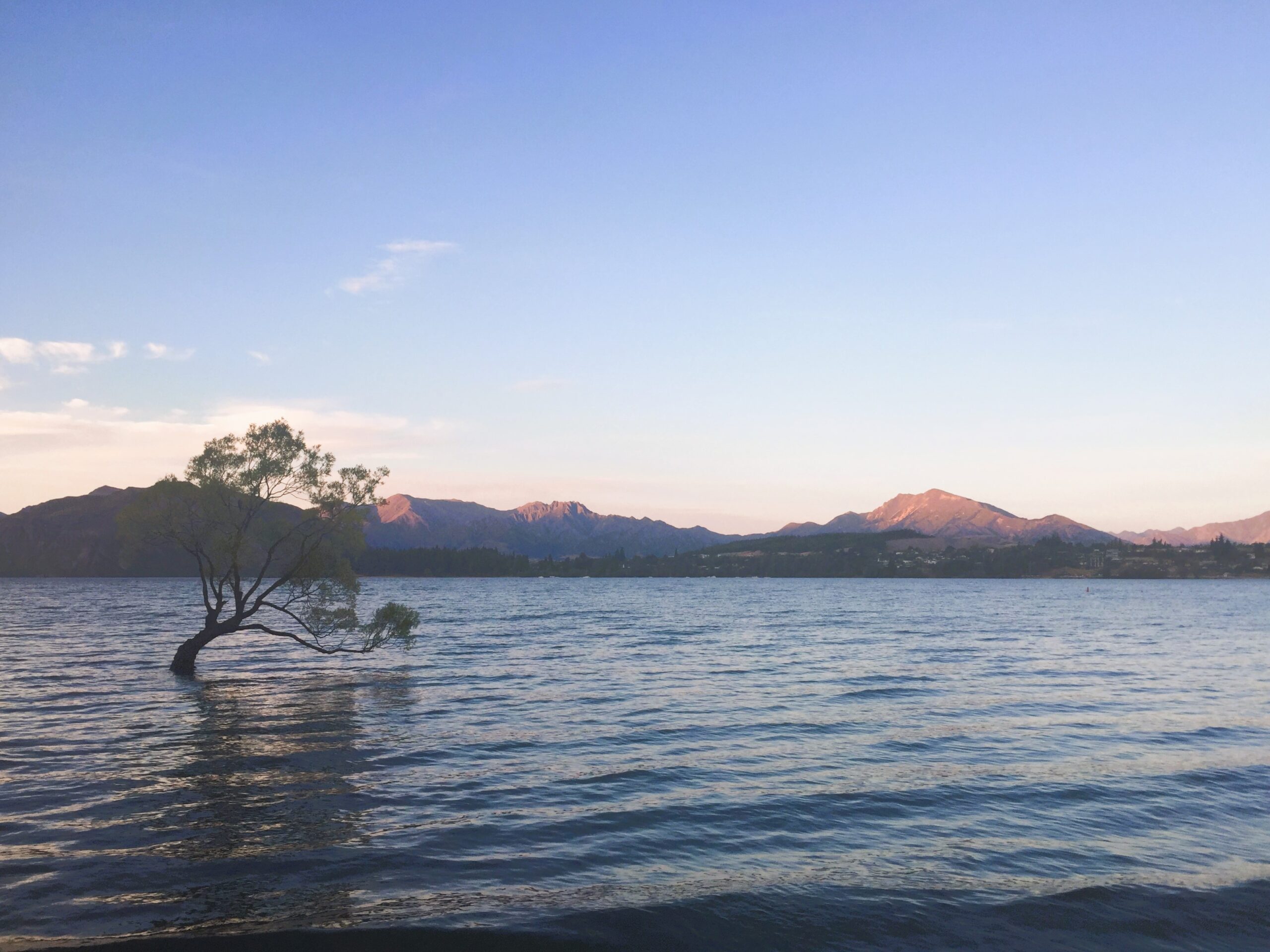
Situated on the shores of Lake Wānaka, this charming town is surrounded by mountain peaks and rolling hills. Wānaka feels like Queenstown’s more relaxed cousin—less hustle, same jaw-dropping scenery, and plenty of things to do.
It’s also the gateway to Mount Aspiring National Park, so hiking and climbing options are endless around here. The ski fields of Treble Cone and Cardrona are also within reach. The town has become a must-visit destination for backpackers seeking adventure, stunning landscapes, and a laid-back vibe.
🚙 Getting there: Wānaka is a 1 hour drive north from Queenstown. There’s also daily Intercity services. Plus hop-on hop-off tours like Kiwi Experience.
Roys Peak Track
This climb is legendary. Yes—this is the iconic hike you’ve seen all over Instagram. It’s a steep climb—about 16 km return—but the views over Lake Wānaka, the Southern Alps, and Mount Aspiring are breathtaking.
You’re looking at about 5-6 hours total hiking time—and an easy to intermediate level grade. But be prepared to climb 1,500 metres.
If you only do a handful of hikes in the South Island, the Roys Peak Track should be one of them.
🌄 Pro tip: For a quieter experience, we highly recommend you start before dawn or go in shoulder season (April – October). Sunrise at the summit is pure magic.

Wānaka Paragliding
Take to the skies! Paragliding in Wānaka gives you an unforgettable bird’s-eye view of lakes, peaks, and valleys. This is one of the best places in New Zealand to experience paragliding, offering a thrilling way to take in the breathtaking alpine scenery.
Picture yourself launching from the slopes of Roys Peak and soaring high above the town, with panoramic views of Lake Wānaka and the Southern Alps. The wind conditions here are ideal, making it a popular spot for both beginners and experienced flyers.
For first-timers, tandem paragliding is the perfect intro. You’ll be strapped to an experienced instructor who guides you through each step of the flight, so all you need to do is relax and enjoy the view.
Whether you’re after an adrenaline hit or just want to tick off something epic from your bucket list, paragliding in Wānaka is an experience you won’t forget. Plus, it’s a unique way to truly appreciate the region’s natural beauty from a whole new perspective!
Bonus: That Wānaka Tree
We tossed and turned over this one. Yes, technically it’s a single tree (a willow FYI) in a lake, but it’s become a bit of a legend. Drumroll…
The iconic That Wānaka Tree is one of the most famous attractions in the Otago area. Actually anywhere in New Zealand for that matter. You’ll find it down by the lakefront, a short walk from town.
Trust us, you’ll know it when you see it. Look for a group of people standing around a tree by the lake. Seriously, you can’t miss it.
Ok back to business—do get up early and go see it, the best time for photos is sunrise when the light hits Lake Wānaka just right. It’s a short and sweet encounter that’ll make your backpacking New Zealand experience that much more real.
🛌 Where to stay: Adventure Wānaka Hostel | Haka House Wānaka.
7. Kaikōura: Whales, seals, and ocean views
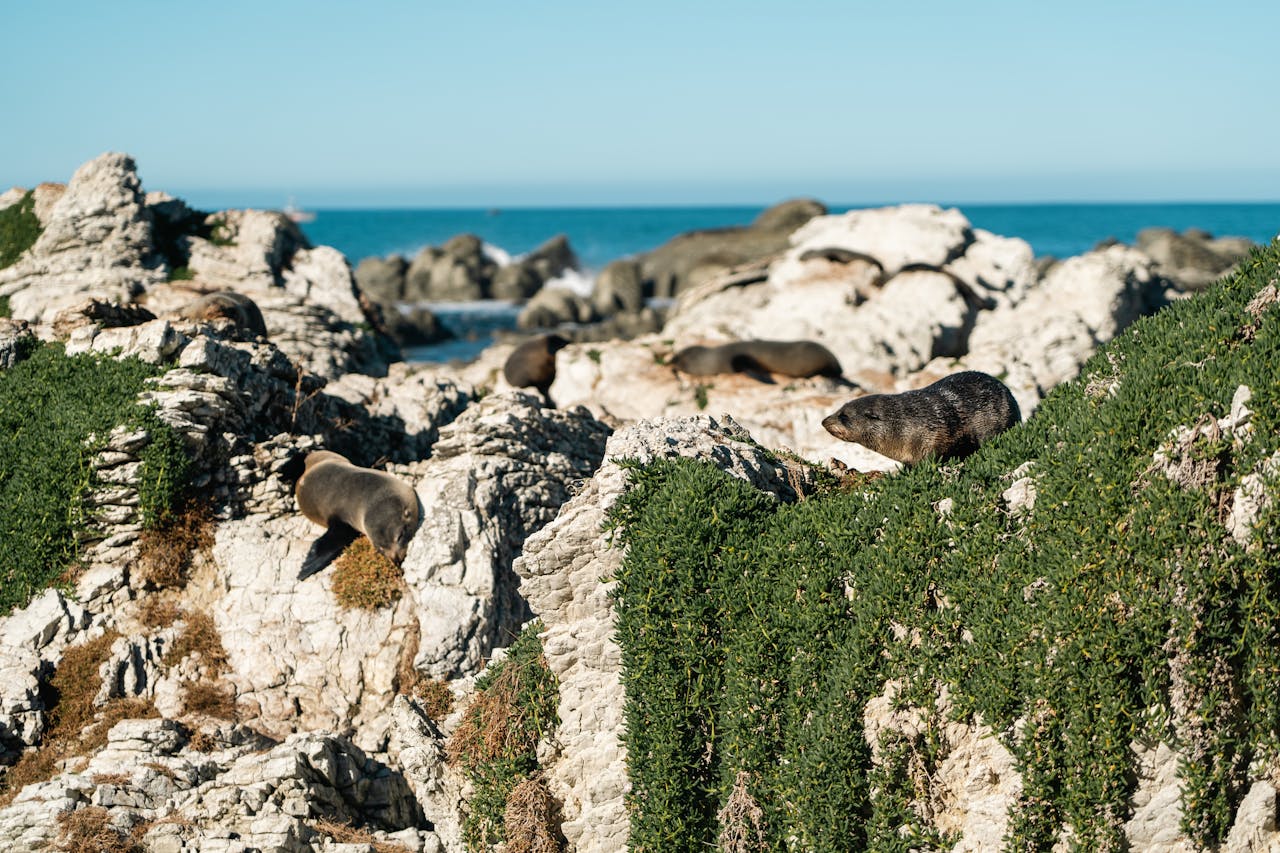
Chances are you’re driving along State Highway 1 towards Kaikōura and you’re spotting something out of the corner of your eye. It’s not long before you’re pulling the campervan over—dozens of seals adorn the rocky outcrops along the coastline.
The next morning, you wake up to a pod of dolphins swimming past your campsite. Few places in the world cram so much wildlife into such stunning scenery—this place is one big show off!
Kaikōura is a rugged coastal town where snow-dusted mountains rise straight out of the Pacific Ocean. The deep trench offshore creates the perfect feeding ground for whales, dolphins, and seals—meaning you’re basically guaranteed wildlife encounters every day.
The smell of salty air mixes with fish and chips on the breeze, and seabirds circle dramatically overhead (which can actually get quite annoying). Watch your lunch!
Walk the Kaikōura Peninsula Track for sweeping ocean views and plenty of wildlife spotting. Kaikōura is where the mountains meet the sea—and where marine life thrives like nowhere else in New Zealand.
🚙 Getting there: Kaikōura is a 2 hour 20 minute drive north from Christchurch. There’s also daily Intercity services. Plus hop-on hop-off tours like Kiwi Experience.
Whale Watch Kaikōura
This is an absolute bucket-list experience for wildlife lovers. Located on the east coast of the South Island, Kaikōura is one of the best places in the world to spot sperm whales.
Whale Watch Kaikōura run unforgettable sustainable tours that bring you up close to these majestic giants. The waters here are nutrient-rich, creating the perfect environment for marine life, that attracts giant whales year-round—making sightings almost guaranteed. If you don’t see one you’ll get a partial refund!
Tours typically last around 3 hours, during which you’ll cruise out to the deep waters off the coast. You’ll have the chance to spot not only sperm whales, but also dolphins, seals, and even the occasional orca. Guides provide fascinating insights into the marine ecosystem and the conservation efforts in place to protect these incredible creatures.
The thrill of watching a sperm whale breach the surface, or seeing it dive into the depths, is indescribable. If you’re looking to experience the awe-inspiring power of nature, Whale Watch Kaikōura is a must-do adventure that will leave you speechless.
Swim with dolphins
Swimming with dolphins in Kaikōura is an exhilarating, once-in-a-lifetime encounter that draws travellers from around the globe. The waters off this coastal town are home to a resident population of dusky dolphins, known for their playful and curious nature. Tours are run by experienced guides who prioritise the well-being of the dolphins, and follow strict ethical guidelines, so encounters are environmentally conscious and respectful.
Once you’re suited up in a wetsuit and snorkel gear, you’ll head out on a boat to a prime dolphin hotspot. Kaikōura’s dusky dolphins are incredibly friendly and will usually approach you. They’ll often swim right beside you in the open ocean—creating an intimate connection that’s pretty hard to beat. The interaction offers a rare opportunity to witness the intelligence and charm of these incredible marine mammals up close.
The tours also educate you about the dolphins’ behavior, conservation efforts, and local marine life, making it not just a fun adventure but an informative one too. Swimming with dolphins in Kaikōura is the kind of experience that leaves you with lasting memories—and a deep appreciation for marine wildlife.
Heads up—take seasickness tablets if you’re prone to motion sickness. The water can be choppy!
🛌 Where to stay: Dusky Lodge & Backpackers.
8. Golden Bay: Wild, remote, and stunning

For those that appreciate off-the-grid adventures, you’ll love Golden Bay. This area lies beyond the twisty Tākaka Hill road in the northwest of the South Island. Once you arrive, you’ll feel like you’ve discovered another world—a hidden corner of New Zealand. Tākaka is the first stop here, and a charming little town with a hippie soul.
Golden Bay has a rich cultural history, with Māori tribes having settled here centuries ago, and you’ll find local galleries and artisan shops showcasing the work of the region’s creative community. Surrounded by rugged mountains and a stunning coastline, Golden Bay is a great place to disconnect and recharge in nature.
🚙 Getting there: Collingwood (the last town before Wharariki) is a 2 hour 45 minute drive northwest from Nelson.
Wharariki Beach
This beach is known for its raw beauty—a mix of sweeping golden sands and dunes, dramatic sea stacks, and powerful waves. A short 20 minute walk from the carpark reveals incredible views.
Wharariki is hands-down one of the most dramatic beaches in New Zealand. It’s also one of the most remote, located at the northwestern tip of the South Island.
The iconic sea stacks—formed by years of erosion—are a must-see. These massive rock arch formations rise from the surf and stand up to 66 metres tall. You might even spot fur seals sunning themselves on the rocks nearby.
Wharariki is also one of the best places in New Zealand to catch a sunset. The untouched landscape here is out of this world, you’ll feel truly off the beaten path.
🦭 Pro tip: Visit Wharariki Beach at low tide to see seal pups playing in rock pools.
Pūponga Hilltop Walk
The Pūponga Hilltop Walk is an advanced and rewarding 8 km hike (one way), offering panoramic views over Cape Farewell—the northernmost point of the South Island.
The full track runs from the Triangle Flat carpark to Wharariki Beach. This 3-5 hour hike takes you through coastal bush, farmland, and along cliffs, with the highlight being the breathtaking coastal views. From the hilltop, you can see across the bay, over to Farewell Spit and the Tasman Sea.
Farewell Spit
Farewell Spit is a unique and stunning natural wonder located at the northern tip of the South Island, where the Tasman Sea meets Golden Bay. Stretching 35 kilometers into the ocean, it’s one of the longest sand spits in the world and an absolute highlight if you’re visiting the area.
The spit is a protected nature reserve, home to diverse wildlife and dramatic landscapes. Its towering sand dunes, salt marshes, and tidal flats create a habitat for thousands of migratory birds, including the endangered New Zealand dotterel.
You can explore the spit on guided eco-tours (the tides here are extreme), which take you to the top of the dunes, with sweeping views of the bay and beyond.
The area is also rich in Māori history, with extensive evidence of Māori occupation (known as Onetahua, “heaped up sand”). A visit to the nearby Farewell Spit Lighthouse, one of New Zealand’s most iconic, is also a must.
🛌 Where to stay: Check out Pākawau Beach Camp (20 minutes from Wharariki).
9. Lake Tekapo: Turquoise waters and star-filled nights
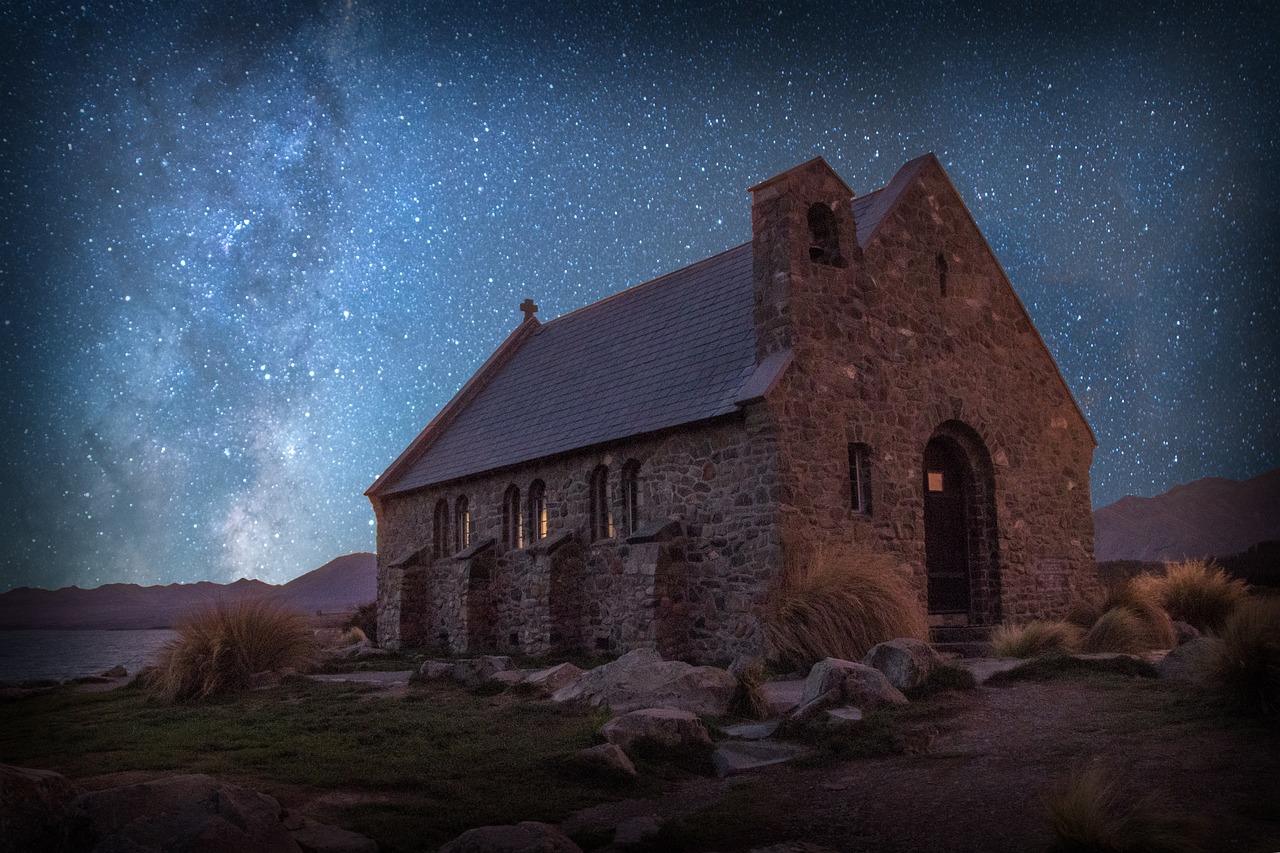
If you’re driving from Christchurch, Lake Tekapo is one of the first major highlights you’ll hit. It’s one of a series of three major lakes on this stretch of State Highway 8—all of which are equally stunning! They’re not edited, we promise!
This spot is famous for its striking turquoise waters, snow-capped peaks, and breathtaking night skies. In summer, purple and pink lupins bloom along the shore. The unique blue colour of the water is actually a result of finely ground rock flour suspended in the lake, giving it that almost surreal, vibrant hue. Lake Tekapo is easily one of the most photogenic spots in the South Island.
The area is also famous for stargazing, as it’s part of the UNESCO Dark Sky Reserve, making it one of the best spots in the world to see the Milky Way.
For those seeking adventure, Tekapo offers plenty of hiking and cycling tracks, and in winter, snow sports at the nearby Roundhill and Mount Dobson ski fields. The town of Tekapo is small but offers a cozy base for backpackers, with a range of accommodation options, cafés, and a laid-back vibe.
🚙 Getting there: Lake Tekapo is a 2 hour 50 minute drive southwest from Christchurch. There’s also daily Intercity services. Plus hop-on hop-off tours like Kiwi Experience.
The Church of the Good Shepherd
This place is the definition of iconic. Perched on the lake’s edge, this tiny stone church is one of New Zealand’s most photographed buildings. It was built in 1935 as a tribute to early settlers, with an altar window that frames Lake Tekapo perfectly.
It’s open to visitors year-round, and it’s still an active place of worship with services every Sunday. For the best shot, visit at dawn when the water is still and the light is soft. It’s also a prime spot to view the Milky Way.
Tekapo Springs and Stargazing
Located on the edge of town, Tekapo Springs offers a range of thermal pools and sauna rooms. The complex directly overlooks Lake Tekapo—so you can soak in stunning views of the lake and surrounding mountains. But what we really love is that it’s also one of the best spots in the region for stargazing. These guys offer the only guided stargazing and hot pools experience in New Zealand.
Evening and early morning tours are available—these include high-powered telescopes, celestial stories, and of course the hot pools!
With the clear skies around Lake Tekapo (as part of the UNESCO Dark Sky Reserve)—the combo of hot springs, alpine scenery, and stargazing makes Tekapo Springs a must-visit if you’re backpacking through the area. You might even see us there!
🛌 Where to stay: Check out Haka House Lake Tekapo.
10. Franz Josef: Glaciers and rainforest adventures
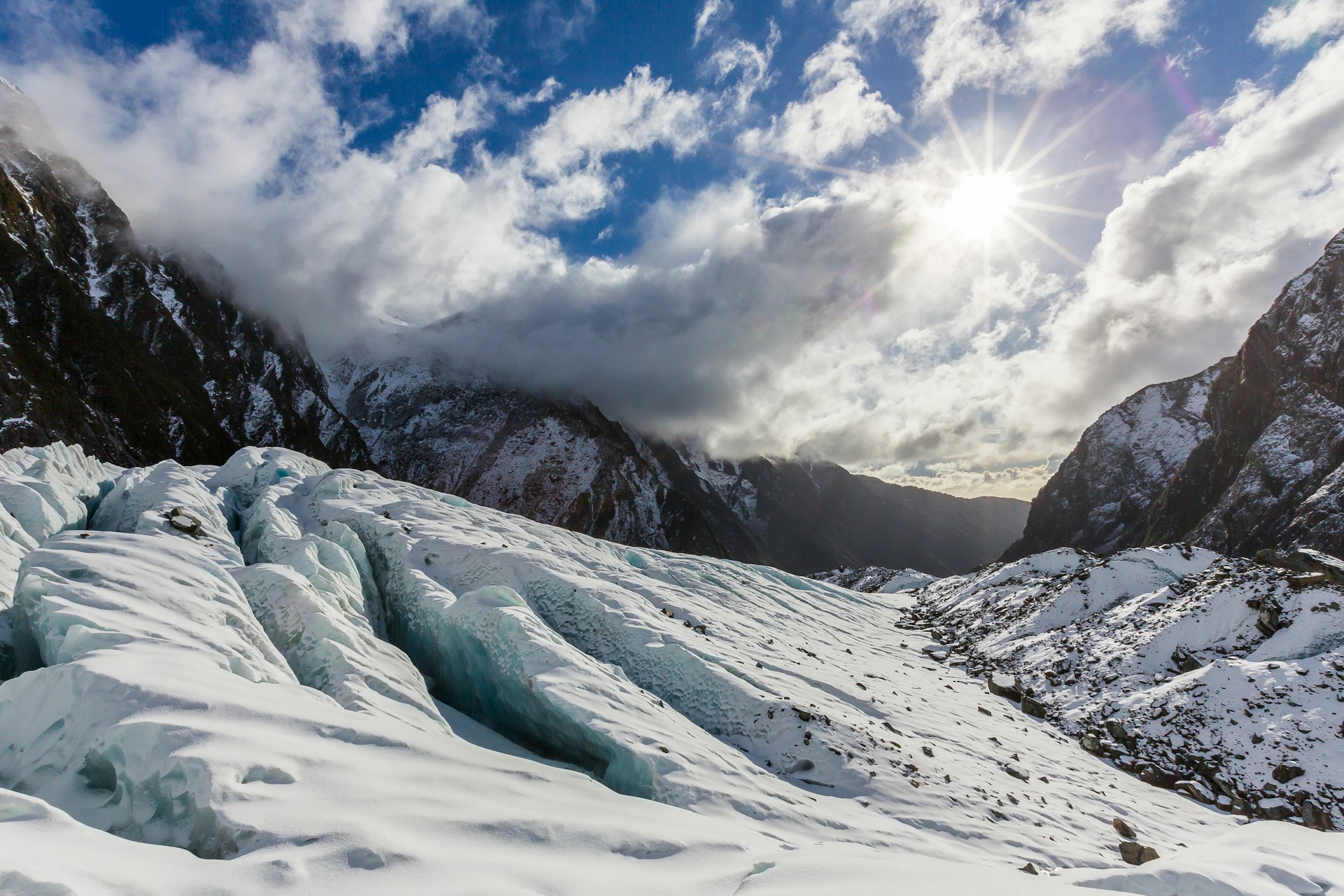
This small town on the West Coast is best known for its glacier. Franz Josef is one of the most accessible glaciers in the world, offering a unique opportunity to get up close to the massive, ancient ice flow. The Heli-Hike combines aerial views with a hands-on glacier experience.
You can take guided hikes, helicopter tours, or even ice-climbing trips to explore the glacier’s unique features. But the beauty of Franz Josef isn’t just about the glacier. The surrounding rainforests, waterfalls, and mountains offer plenty of outdoor adventures, from scenic hikes to adrenaline-fuelled activities.
🚙 Getting there: Franz Josef is a 3 hour 45 minute drive north from Wānaka. There’s also daily Intercity services. Plus hop-on hop-off tours like Kiwi Experience.
Franz Josef Glacier Heli-Hike
The Heli-Hike is one of New Zealand’s most epic adventures, and one of the best ways to experience this natural wonder.
This unique experience combines a scenic helicopter flight with a guided hike on the glacier itself, allowing you to access parts of the ice that are otherwise off-limits to regular trekkers. The flight takes you over dense rainforests and rugged terrain before landing on the glacier, where you’ll get to step out onto the ice.
Once on the glacier, expert guides lead you on a hike, navigating through ice caves and over crevasses, climbing frozen ridges, and exploring the ever-changing landscape.
The glacier’s unique formations and blue-tinted ice are visually stunning, and something really special to witness up close. Plus, with your guide’s insights into the glacier’s formation and the surrounding area, you’ll learn about the region’s history and geology.
Canavans Knob Walk
If you’d rather stay grounded, this easy 3.2 km (1 hour) return trail rewards you with views of the Franz Josef Glacier, Southern Alps, and Tasman Sea. If you’re hiking from town you’re looking at a total of 6.3 km (1 hour 40 minutes) return.
For something more challenging, with next-level views of the glacier, check out the Roberts Point Track. There are also many other hiking options available here. These hikes are an easy way to experience the natural beauty of the area.
🏞️ Pro tip: Weather changes fast here. Check with the local DOC office before hiking—heavy rain can close the track.
Bonus: Waiho Hot Tubs
Soak in your own freshwater hot tub under a rainforest canopy! Each one is filled with fresh, pure mountain stream water—no nasty chemicals here.
Waiho Hot Tubs is a highly-rated, unique experience and a must-do when visiting Franz Josef. Booking in advance is highly recommended due to popularity.
Time to bliss-out—don’t forget to think of us when you’re in there!
🛌 Where to stay: Haka House Franz Josef | Rainforest Retreat.
The land of endless adventure
One word. EPIC.
Every time we backpack the South Island we get that rush of excitement. Your spirit knows it’s in the land of endless adventure. Driving around every corner is a wow moment—like seeing postcard after postcard.
Honestly, just cruising around in a campervan is enough to make you pinch yourself. You’re actually doing this!
If you can, give yourself time—at least two to three weeks—to explore properly. Take the scenic routes, camp under the stars, and let the road surprise you. The South Island is wild, raw, and less populated than the North.
You’ll be blown away by the beauty, and when you hit the things to do in our guide you probably won’t want to leave. Just saying ✌🏼
⭐ Heading to the North Island? Discover all our faves in our dedicated guide: 25 best things to do in New Zealand: North Island highlights.
Backpacking New Zealand tips
- 🚗 Watch the road conditions: While most roads are generally well-maintained, some routes, especially in the mountains or around the fjords, can be narrow and winding. Take your time, drive carefully, and always check road conditions in winter or stormy weather.
- 🏕️ Use DOC campsites: The Department of Conservation (DOC) offers affordable campsites in stunning locations across the South Island. These are a great way to save on accommodation (versus holiday parks).
- 🌧️ Always check the weather: South Island weather can be highly unpredictable, even in summer. Especially in alpine environments—calm weather can flip like a switch up here. Use MetService for the most accurate forecast.
- 🥾 Hike early or late: For less crowded trails, start hikes early in the morning or later in the afternoon. Many of the popular tracks like Roys Peak can get busy during peak season.
- 👀 Keep an eye out for wildlife: The South Island is a wildlife paradise. From penguins to seals to the rare Hector’s dolphin, keep your eyes peeled for native animals, especially in places like Kaikōura, Stewart Island, and the Otago Peninsula.
👉🏼 Check out our Beginner’s guide to backpacking New Zealand for everything you need to know, or visit our FAQ.

